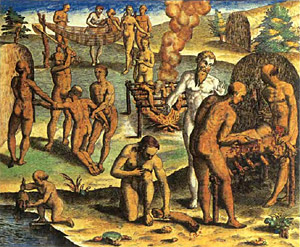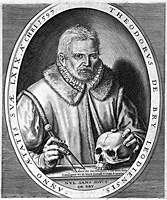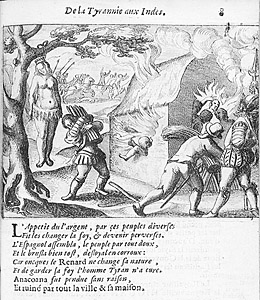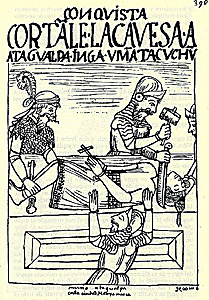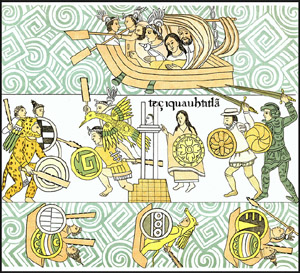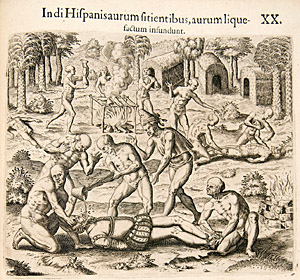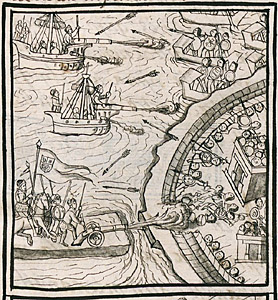Conquest of the Americas
Why is this important in the context of seeing?
Obviously there are two sides of the story, but less known is that both views are well documented. It all started with greed: gold and silver. Discoveries were important, but what they found were two entire continents! Times may have been different, but both the Spaniards and the Indigenous people engaged in immense atrocities. News about what was happening was biased and twisted. Nothing has changed and people will never learn.
While European artists like Theodor de BRY were producing images that reflected colonial biases, Indigenous artists in the Americas were also creating visual records of European atrocities. Works like Guaman POMA's 'Nueva Corónica', 'the Florentine Codex', and other indigenous codices offer invaluable perspectives on the suffering, violence, and exploitation that accompanied colonization. These works provide a counter-narrative to the often romanticized or distorted European portrayals of the New World and its people.
the orange numbers refer to the corresponding slides
11-06 Theodor de BRY
Theodor de BRY (1528–1598) was a prominent 16th-century engraver, editor, and publisher, originally from what is now Belgium (then part of the Holy Roman Empire). He is best known for his detailed and influential engravings that depicted the Americas during the Age of Exploration. His works helped shape European perceptions of the New World and its Indigenous peoples, although these depictions were often heavily stylized and biased, influenced by the European perspectives of the time./p>
- category:
- artist: artist and cartographer Jacques Le Moyne de Morgues, engraved by Therodore de BRY
- date: 1564
- website: researchgate.net
- references
- photo credits & links
- www.debryrarebooks.com
The Latin phrase "Brevis narratio eorum quae in Florida Americae provincia Gallis acciderunt" translates to: "A brief account of those things which happened to the French in the province of Florida in America." This phrase is the title of a 16th-century work by the French artist and cartographer Jacques Le Moyne de Morgues, which describes early French explorations in Florida.
11-06-2 (self)portrait of Theodor de Bry
Early Life and Background:
" : Birthplace: Theodor de Bry was born in Liège (modern-day Belgium) in 1528 to a family of goldsmiths. He initially trained as a goldsmith and engraver, a skill he would later apply to his famous prints.
: Religious Persecution: As a Protestant in a predominantly Catholic region, de Bry faced religious persecution. He eventually fled to Strasbourg, which was a center for Protestantism, and later moved to Frankfurt am Main, where he spent much of his career.
Major Works and Influence
Depictions of the Americas: De Bry is most famous for his series of illustrated books based on the European exploration of the Americas. These books, collectively known as the "Grand Voyages" (Americae), contained engravings based on the accounts of explorers such as Christopher Columbus, Hernán Cortés, and Amerigo Vespucci, as well as accounts from British colonizers like Sir Walter Raleigh.
His engravings often illustrated the encounters between Europeans and indigenous peoples, and many were based on earlier sketches, such as those by John White, an English artist who documented the Roanoke Colony in present-day North Carolina. However, de Bry’s works were highly romanticized and Eurocentric, often exaggerating the "exotic" aspects of Native American life and culture, and at times emphasizing violent encounters.
"Les Grands Voyages" and "Petits Voyages":
The Grand Voyages focused on the Americas, while the Petits Voyages covered travels to other parts of the world, including Asia and Africa. Both series were published in multiple volumes and were widely circulated across Europe. These works were among the first comprehensive visual records of the world outside Europe and contributed to the growth of European colonialism.
Artistic Style and Legacy
Engraving Style: De Bry’s engravings are known for their intricate detail, use of shading, and dramatic compositions. While the images were meant to be educational, they often reflected European fears and fantasies about the "unknown" New World. Native peoples were often portrayed in ways that emphasized their otherness or savagery, in line with the colonial narratives of the time.
Influence on European Perception: His illustrations greatly influenced how Europeans understood and imagined distant lands. His works fed into the European fascination with the Americas, promoting ideas of exploration, conquest, and colonization. However, many of de Bry’s representations were inaccurate or exaggerated, sometimes presenting indigenous peoples as barbaric or cannibalistic, which reinforced negative stereotypes.
Publishing Business: De Bry's publishing house in Frankfurt became a major center for the production of travel literature. After his death, his sons Johannes Theodor de Bry and Johannes Israel de Bry continued the family business, further expanding the Grand Voyages series.
Criticism and Historical Impact
While de Bry's works are considered masterpieces of engraving, they are also criticized for their distortions and the propagandistic nature of many of the illustrations. They played a role in justifying European imperialism by depicting indigenous people as uncivilized or barbaric, in need of Christianization or conquest.
In sum, Theodor de Bry played a significant role in shaping early modern European views of the New World, although the legacy of his work is complex, blending both artistic achievement and cultural distortion."
Link:
Citation: Dr. Lauren Kilroy-Ewbank, "Inventing “America” for Europe: Theodore de Bry," in Smarthistory, May 22, 2019, accessed September 3, 2024, smarthistory.org.
- category: engraving
- artist: Jan Theodor de BRY
- date: 1597
- website: www.rijksmuseum.nl
- references
- photo credits & links
- www.
11-06a Bartolomé de las CASAS
Bartolomé de las Casas (1484–1566) was a Spanish Dominican friar and early human rights advocate. Initially involved in Spanish colonization, he later renounced his role after witnessing the brutal treatment of Indigenous people. He dedicated his life to defending their rights, arguing they were fully human and deserved humane treatment. His most famous work, A Short Account of the Destruction of the Indies (1552), exposed colonial atrocities. He also influenced the New Laws of 1542, aimed at protecting Indigenous people. De las Casas is remembered for his opposition to the exploitation of native populations during the Spanish colonization.
- date: 1552
- website: archive,org
- references
- photo credits & links
- Link to book: GYSIUS, Johannes and LAS CASAS, Bartolomé de Le miroir de la cruelle, & horrible tyrannie espagnole perpetree au Pays Bas www.sokol.co.uk
The Mirror of Cruel and Horrible Spanish Tyranny Perpetrated in the Netherlands by the Tyrant Duke of Alba and Other Commanders of King Philip II, Published in the Netherlands in 1620. French translations of two earlier works detailing the atrocities and crimes committed by the Spanish in Europe and the New World.
I - Johannes Gysius (died in 1652) – Origin and Evolution of the Troubles in the Netherlands, 1616.
II - Bartolomé de las Casas (1474–1566) – A Short Account of the Destruction of the Indies, written in 1542, published in 1552.
11-06b Felipe Guaman POMA de Ayala
Guaman Poma (c. 1535–after 1616) was a Quechua nobleman from what is now Peru. His monumental work, written around 1615, was addressed to King Philip III of Spain, and it documents the history of the Andean people before and after the Spanish conquest. The work includes more than 400 illustrations, many of which depict the brutal treatment of indigenous people by Spanish colonizers.
Perspective on Atrocities: His drawings show the mistreatment and violence indigenous people suffered under Spanish rule, including forced labor, torture, and murder. Guaman Poma’s work is particularly valuable because it offers a direct indigenous perspective on the horrors of colonization.
Style: His illustrations are less detailed than those of European engravers like de Bry, but they are expressive and clearly convey the suffering of Indigenous people. His work is a combination of Andean and European influences.
- title: 'El Primer Nueva Corónica y Buen Gobierno' (The First New Chronicle and Good Government)
- artist: Guaman Poma
- date: 1615
- website: https://poma.kb.dk/permalink/2006/poma/info/en/frontpage.htm
- references
- photo credits & links
11-06c Lienzo de_TLAXCALA Teciquauhtitla
Background: The Lienzo de Tlaxcala is a large pictorial document created in the late 16th century by the Tlaxcalans, who were allies of Hernán Cortés during the Spanish conquest of the Aztec Empire. It was made to depict their role in the conquest and highlight the atrocities committed against the Aztecs, as well as their own contributions to the Spanish victory.
Indigenous Perspective: While it was created by a group that sided with the Spanish, the Lienzo also contains imagery of the violence of the conquest, including battles, massacres, and the destruction of indigenous cities. It provides insight into how native allies of the Spanish viewed the conquest and its atrocities.
Style: The Lienzo is a codex-style document with indigenous pictorial traditions, using vibrant, symbolic images to represent historical events. The images are more stylized and symbolic compared to European art.
- title: Lienzo de Tlaxcala (The Tlaxcala Canvas)
- artist: the Tlaxcalans
- date: 1773 Reproduction from 1584 original version of the Lienzo de Tlaxcala.
- website: Lienzo de Tlaxcala pdf (spanish)
- references
- photo credits & links
- www.latinamericanstudies.org
wikimedia.org
11-06d Códice Azcatitlan
Work: The Códice Azcatitlan is another post-conquest Nahua manuscript, which visually narrates the history of the Mexica (Aztec) people, from their origins through the Spanish conquest.Perspective on Atrocities: It includes scenes depicting the arrival of the Spanish and the violent confrontations between them and the indigenous people. It shows battles, the death of indigenous leaders, and the overall devastation brought by European conquest.
Style: Like other indigenous codices, the Códice Azcatitlan uses a mix of pre-Hispanic iconography and post-conquest influences, blending traditional native artistic methods with European elements.
- title: Códice Azcatitlan
- date: some time between the mid-16th and 17th centuries
- references
- photo credits and more links
en.wikipedia.org
the orange numbers refer to the corresponding slides
11-06e Códice Mendoza
Work: The Códice Mendoza was commissioned by Spanish authorities around 1541 to document the history, economy, and culture of the Mexica (Aztecs). Although commissioned by the Spanish, it was created by indigenous artists.Perspective on Atrocities: It contains scenes depicting Spanish attacks on indigenous people and the forced subjugation of native populations. The indigenous artists portrayed the brutal conquest with images showing the violence and suffering inflicted upon the Mexica by the conquistadors.
Style: Similar to other codices, the style is a mix of traditional indigenous iconography and European influences, with highly symbolic representations of historical events.
- title:
- artist: indigenous artists
- date: 1541
- website: codicemendoza.inah.gob.mx
- references
- photo credits & links
11-06f Códice Huexotzinco
Work: The Códice Huexotzinco (1531) is a pictorial document produced by the indigenous people of Huexotzinco (in present-day Mexico) to protest Spanish colonial abuses, particularly the excessive taxation imposed on them. Indigenous Perspective: The codex contains imagery showing the exploitation and violence inflicted upon indigenous people by the Spanish. It was used as evidence in a legal case against the Spanish authorities, representing a direct indigenous critique of colonial oppression. Style: The document blends indigenous and European artistic traditions, with a focus on storytelling through symbolic imagery.- title:: Códice Huexotzinco
- artist: the indigenous people of Huexotzinco (in present-day Mexico)
- date: 1531
- website:
- references
- photo credits & links
- www.loc.gov slideshow
11-06g The Florentine Codex (Bernardino de SAHAGÚN and Indigenous Artists)
Work: Historia General de las Cosas de Nueva España (General History of the Things of New Spain), also known as the Florentine Codex.
Background: The Florentine Codex was compiled between 1545 and 1590 by the Franciscan friar Bernardino de Sahagún, with the assistance of indigenous Nahua scholars and artists. It documents many aspects of Aztec life, history, and culture, as well as the Spanish conquest of Mexico.
Indigenous Perspective: Several illustrations within the codex depict the brutality of the Spanish conquest from the indigenous perspective, including massacres and the destruction of indigenous cities. These images, created by indigenous artists, offer an alternative to the European narratives of conquest. They show how native people experienced the violence, portraying scenes of death, suffering, and oppression.
Style: The codex includes both text in Nahuatl and Spanish, along with hundreds of illustrations. The indigenous artists drew in a style influenced by their pre-Hispanic traditions but also incorporated elements of European art, making the images a fusion of two worlds.
Link: https://en.wikipedia.org/wiki/Florentine_Codex
Picture: BEN5463344 Codex of the conquest of Mexico: The Spanish attack the city of Xolloco. Miniature of the Florentine manuscript Storia degli Aztechi (History of the Aztecs) by Bernardino de Sahagun, 1569-1575. Ref: MS. Pal.220, Book 12, Cap.30. Biblioteca Medicea Laurenziana, Florence. by Spanish School, (16th century); Photo: © Raffaello Bencini / Bridgeman Images
- references
- photo credits & links
- www.loc.gov
- Link: https://www.mediastorehouse.com.au/fine-art-finder/artists/leopold-emile-rutlinger/codex-conquest-mexico-spanish-attack-city-33095428.html
the orange numbers refer to the corresponding slides
11-06h 'Fall of Tenochtitlan'
Work:- title painting: "Conquista de México por Cortés"
- artist unknown:
- date: 1521
- website: www.worldhistory.org
- references
- photo credits & links
- wikipedia.org It was the siege of Tenochtitlan that directly led to the fall of the Aztec civilization and the ensuing sacking and violence against the survivors.
- Link: La Noche Triste

